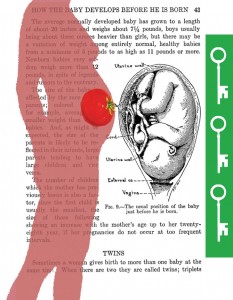Being Jewish
Commentary
Commentary: The Pages of Pregnancy
For the first time today, I felt the baby inside me kicking. It happened while I was learning Daf Yomi (daily Talmud lesson), which deals with the period of time a woman is considered impure after giving birth to a girl (Zevahim 38). Is it two weeks (shvuaim), as per the pro nounced form of the word in the Torah? Or is it 70 days (shivim), as the spelling of the biblical word seems to indicate? The baby continued kicking until the dispute was resolved, and I could rest assured that the creature inside me enjoys learning Talmud as much as I do.

If all goes well, this pregnancy will last me through the tractates of Zevahim and Menahot, and the child will be born with full knowledge of both animal and vegetable sacrifices. Of course, I know that the baby will inevitably forget all its Torah when the angel strikes it on the mouth as soon as it takes its first breath (Niddah 30b). Still, I like to think that the clouds of glory it trails from the womb will be the pages of Talmud I have learned these past few months, my book resting atop my growing belly.
This week the pregnancy books tell me that the baby is the size of an heirloom tomato, though I find these weekly produce updates baffling. Instead, I prefer to use the Talmud’s measurements: When I first found out I was pregnant, the baby was a k’zayit, the size of an olive. A month later, it was a k’beitza, the size of an egg—which is also odd, since ostensibly it started out as an egg in the first place. And while I don’t know much about labor, I trust it will take significantly longer than k’dei akhilat pras—the time it takes to eat three egg-sized pieces of bread with relish.
It is hard to imagine the delivery, about a month after Passover. God-willing, at the Seder I will be singing “asara yarhei leida” (10 months of gestation”) instead of “tish’a” (9), since a pregnancy technically lasts 40 weeks. I hope that as I sing, the baby will join in a chorus of “Song of the Sea,” imagining itself as if it too has been delivered from bondage. I think about the Exodus from Mitzrayim (Egypt), which means narrow, and which the rabbis liken to the birth canal. Perhaps by Passover I will feel the pangs of redemption.
Still, if there is anything I have learned about pregnancy, it is to appreciate the many miracles involved in the creation of new life. Every stage of this process fills me with awe and gratitude, and I have much to pray for in the coming months.
The Talmud (Taanit 2a) teaches there are three keys in the hands of God that are not entrusted to any messenger. These are the key to rain, the key to childbirth and the key to the revival of the dead. We pray for the first and third keys during the second blessing of the Amida prayer, where we ask God for rain and to revive the dead. And so I have begun praying for the health and welfare of the unborn child inside me each time I come to this blessing.
When I don’t have time for formal prayer, I simply place my hand on my stomach and recite a version of the prayer attributed to the mother of Rabbi Yehoshua. We read in Pirke Avot that Rabbi Yehoshua’s teacher praised him, saying, “Blessed is the one who gave birth to him.” Rashi explains that Rabbi Yehoshua’s pregnant mother used to pass by the study houses and ask the sages, “Please pray that this unborn child should become a Torah scholar.”
I vary her prayer slightly: “Please pray for this unborn child that he or she should become a Torah scholar, be healthy and be kind.” Perhaps that is a lot to ask for, especially given how many blessings I have received already. Each morning I wake up, look down at my stomach, and bless God who, in His goodness, renews creation every day. I imagine that the flutter I feel inside me is a tiny egg-sized head nodding in assent.










 Facebook
Facebook Instagram
Instagram Twitter
Twitter
Leave a Reply